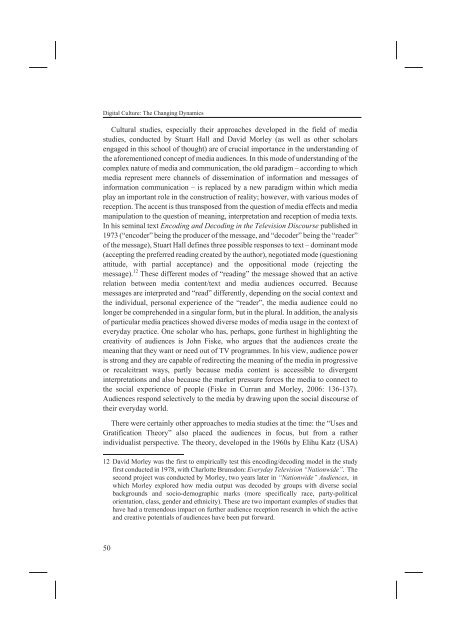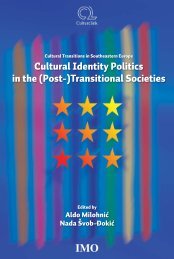D:\Documents and Settings\Ana\My Documents\Biserka-knjiga ...
D:\Documents and Settings\Ana\My Documents\Biserka-knjiga ...
D:\Documents and Settings\Ana\My Documents\Biserka-knjiga ...
You also want an ePaper? Increase the reach of your titles
YUMPU automatically turns print PDFs into web optimized ePapers that Google loves.
Digital Culture: The Changing Dynamics<br />
Cultural studies, especially their approaches developed in the field of media<br />
studies, conducted by Stuart Hall <strong>and</strong> David Morley (as well as other scholars<br />
engaged in this school of thought) are of crucial importance in the underst<strong>and</strong>ing of<br />
the aforementioned concept of media audiences. In this mode of underst<strong>and</strong>ing of the<br />
complex nature of media <strong>and</strong> communication, the old paradigm – according to which<br />
media represent mere channels of dissemination of information <strong>and</strong> messages of<br />
information communication – is replaced by a new paradigm within which media<br />
play an important role in the construction of reality; however, with various modes of<br />
reception. The accent is thus transposed from the question of media effects <strong>and</strong> media<br />
manipulation to the question of meaning, interpretation <strong>and</strong> reception of media texts.<br />
In his seminal text Encoding <strong>and</strong> Decoding in the Television Discourse published in<br />
1973 (“encoder” being the producer of the message, <strong>and</strong> “decoder” being the “reader”<br />
of the message), Stuart Hall defines three possible responses to text – dominant mode<br />
(accepting the preferred reading created by the author), negotiated mode (questioning<br />
attitude, with partial acceptance) <strong>and</strong> the oppositional mode (rejecting the<br />
message). 12 These different modes of “reading” the message showed that an active<br />
relation between media content/text <strong>and</strong> media audiences occurred. Because<br />
messages are interpreted <strong>and</strong> “read” differently, depending on the social context <strong>and</strong><br />
the individual, personal experience of the “reader”, the media audience could no<br />
longer be comprehended in a singular form, but in the plural. In addition, the analysis<br />
of particular media practices showed diverse modes of media usage in the context of<br />
everyday practice. One scholar who has, perhaps, gone furthest in highlighting the<br />
creativity of audiences is John Fiske, who argues that the audiences create the<br />
meaning that they want or need out of TV programmes. In his view, audience power<br />
is strong <strong>and</strong> they are capable of redirecting the meaning of the media in progressive<br />
or recalcitrant ways, partly because media content is accessible to divergent<br />
interpretations <strong>and</strong> also because the market pressure forces the media to connect to<br />
the social experience of people (Fiske in Curran <strong>and</strong> Morley, 2006: 136-137).<br />
Audiences respond selectively to the media by drawing upon the social discourse of<br />
their everyday world.<br />
There were certainly other approaches to media studies at the time: the “Uses <strong>and</strong><br />
Gratification Theory” also placed the audiences in focus, but from a rather<br />
individualist perspective. The theory, developed in the 1960s by Elihu Katz (USA)<br />
12 David Morley was the first to empirically test this encoding/decoding model in the study<br />
first conducted in 1978, with Charlotte Brunsdon: Everyday Television “Nationwide”. The<br />
second project was conducted by Morley, two years later in “Nationwide” Audiences, in<br />
which Morley explored how media output was decoded by groups with diverse social<br />
backgrounds <strong>and</strong> socio-demographic marks (more specifically race, party-political<br />
orientation, class, gender <strong>and</strong> ethnicity). These are two important examples of studies that<br />
have had a tremendous impact on further audience reception research in which the active<br />
<strong>and</strong> creative potentials of audiences have been put forward.<br />
50



